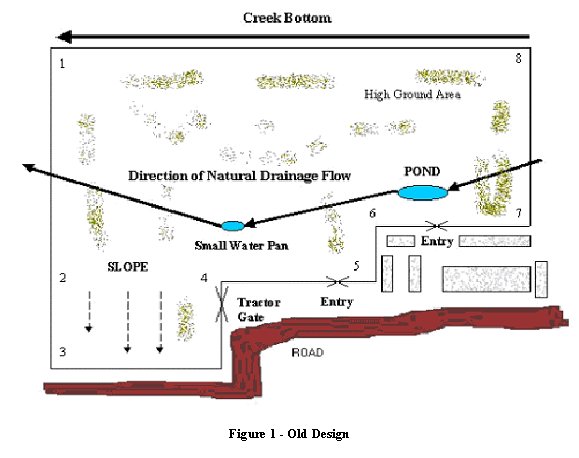
Rebuilding a Starting Pen
At some point your starting pen will start to deteriorate due to aging brush piles, older tree growth, feed strips that donít produce good feed crops, and your rabbit population doesnít reproduce well. When you get to this point, and even Beagle clubs get there eventually, itís time for a massive rebuilding effort. It happened to me this past spring and, after a short time for re-conditioning, my rabbit population is now back with a vengeance. Iíve described in this article some of the actions I took to clean up my pen and re-create a great place to start and train hounds as well as an efficient rabbit-generating habitat.
Planning
Before any clearing took place, I took a look at my existing pen design and tried to determine the impact bulldozing would have on both my existing rabbit population and also on the drainage conditions that might be changed. Bulldozing isnít cheap. A mistake in planning could result in large areas of standing water that will cause serious mosquito problems. Additionally, dampness really hampers rabbit populations, keeps births low, plus wet rabbits are easier for hounds to catch.
What I wanted was larger open areas for new feed strips, controlled drainage and dampness, larger and thicker brush piles then my previous design, while still allowing for easy maintenance during mowing and fence repairs. I didnít want to destroy my current rabbit population or seriously impact them as they adjusted to their new environment.
Iím happy with my current exit points and my concrete bottom standing pond, so the new design needed to support at least these items. Another concern I have is protection from hawks, owls, and other varmints that continuously attack my rabbit population. This means the brush piles need to be near enough to each other that a rabbit can quickly cross open areas, plus the best piles will be high rather then low. Why is this?
Iíve had two serious owl problems in recent years. I can see the trees around and in my pen from my second story deck. Several times Iíve watched the most recent owl perch high up in a tree and watch for movement in my paths. Iíve also seen the owl swoop down over one of the low brush piles in an attempt to get the rabbit to leave the pile. Whatís interesting is that the owl never perched on one of my higher piles. This gave me an idea and I made most of my new piles at least 6 feet high or higher. Iíve now formed an opinion based on watching the owl since Iíve re-build my brush piles. The owl wouldnít come around for the first month or so after the bulldozing was performed. Then it started flying over, and finally it started landing at its old perch outside the pen. Whatís interesting now is that the owl no longer attempts to swoop down and spook a rabbit. In fact, I havenít found an indication that it has even been successful in catching a rabbit. I can say that the higher pile is the reason, but to me it seems that way. Something others should consider in their own pens.

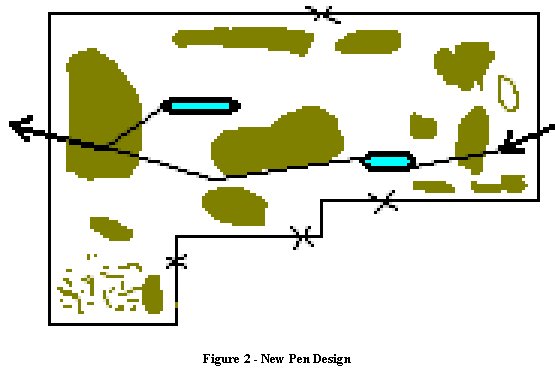
Figures 1 and 2 show the old pen layout and the new design. I decided to create a second po**nd because of the continuous standing water problem I had with drainage in the old design. The new pond has a narrow low area extending into the natural drainage flow that existed previously. The pond is only about 10Ē deep and actually dries up when we donít get rain for a couple of weeks. It does keep the dampness down around my brush piles, plus provides a second watering source easily reachable close to the new brush piles. One note, as shown in the picture, make sure cover grows close to the pond so your rabbits arenít exposed when watering.
Old Tree Growth 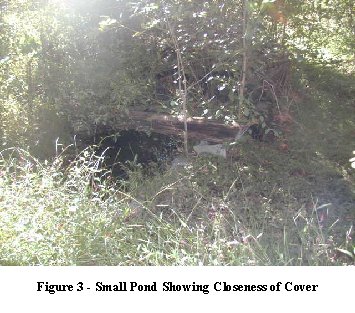
My old cut down tree stumps were working well in growing new limbs each year that I could harvest to re-build my brush piles. However, the problem was that the limbs were all small and the underlying structures of the piles themselves were no longer providing breeding areas or hiding places for rabbits. The situation was simply that the holes and paths under the piles had started filling up with old growth and debris.
My original piles were mostly built with larger logs placed in parallel with cross branches between the logs. Within the piles and between many of the logs I had also placed man made rabbit dens. Unfortunately, after a number of years the trees rotted out and the dens became difficult for the rabbits to reach. While the old brush pile designs worked very well for several years, the only way to fix the problem once they deteriorate was to completely bulldoze the pile and start over.
This time around, however, Iíve added a couple of new tricks that should work much better to prolong the pileís life. The new design is shown in Figure 3. Perhaps the most important improvement is the raised dirt bottom and slight slope under the pile.
During bulldozing, not only did I clear out the old piles completely, but also I dug out the stumps around the piles. These stumps contained the roots and also held a lot of dirt. When the base of the new brush piles were laid out, I slightly elevated the dirt to allow better drainage. Then, after laying the cross logs and adding several of my man-made rabbit dens, both brush and stumps were piled on top. The stump combination of roots and dirt gave me greater room for creating paths under the piles. These paths do not rot out from moisture and collapse as easily as the old paths did. I was also able to put dirt (insulation) around my man-made rabbit dens under the piles, something I couldnít do as easily with the old piles.
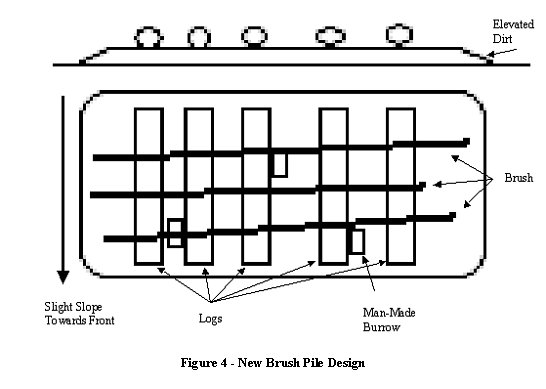
Another advantage of bulldozing was to help me clear out some of the larger trees that had started to choke out sunlight over the years. I couldnít clear out all the trees, as this might have shut off my normal supply of new branches, but now I have only a few trees plus Iíve left the smaller stumps for branch reproduction.
Growth on the Paths
I faced two immediate problems after the initial bulldozing. First, I needed to keep feed available for the existing rabbits, and second, the ground was bare and I needed to get some cover planted to prevent erosion when it rained. I planted oats and rye seed using a rake primarily in clumps on the main strips. I also planted blue grass and clover over the entire area. The oats and rye came up quickly and within a very short time the shoots were at least a foot high. The combination of these new shoots, plus the addition of two new feeders, helped me get through the initial growth period.
 The grass and clover came up slow at first, then the paths really started to fill in. Iím also happy that I can now use a riding mower rather then a bush-hog to mow the paths. After two months, my paths look like well-groomed lawns,
The grass and clover came up slow at first, then the paths really started to fill in. Iím also happy that I can now use a riding mower rather then a bush-hog to mow the paths. After two months, my paths look like well-groomed lawns,
A couple of items of interest I should mention about the grass and my path mowing. Close mowing makes the major rabbit access paths under the brush piles very easy to spot since the old mowed grass has started to build up along the paths. I would have thought that with such large brush piles, rabbits would have used numerous access points. Not so. A hound can enter on end of a pile and I can stand at one of the exit points. Before long out will pop a rabbit.
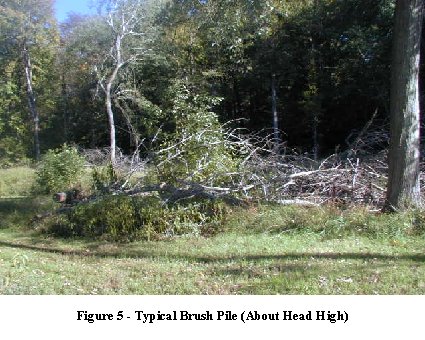 Another thing I noticed is that rabbits are using the old dried up grass to build nests. I had saved some grass shavings from mowing lawns and, after drying, put it into a couple of my burrows before covering. I recently decided to check how my rabbit burrows were working so I cleared out some branches to check one I hadnít put any grass in. While there were no babies in the burrow at the time, the burrow was nearly filled with the shorted cut grass from my paths. My guess is that itís easily brought into these dens and it makes a soft material for rabbits to nest in. This is very similar to what I discovered when I checked the man-made dens on the hill where the evergreens are located.
Another thing I noticed is that rabbits are using the old dried up grass to build nests. I had saved some grass shavings from mowing lawns and, after drying, put it into a couple of my burrows before covering. I recently decided to check how my rabbit burrows were working so I cleared out some branches to check one I hadnít put any grass in. While there were no babies in the burrow at the time, the burrow was nearly filled with the shorted cut grass from my paths. My guess is that itís easily brought into these dens and it makes a soft material for rabbits to nest in. This is very similar to what I discovered when I checked the man-made dens on the hill where the evergreens are located.
Few Negatives
There are only a few negatives Iíve found with my new design so far. The biggest problem I have is getting a hound out if it gets stuck under a pile (only once so far), or getting a hound to come out from a pile when they donít want to. The new piles are serious heaps. Crawling over stumps and branches isnít an easy task for someone my age. Fortunately, however, I have paths all around and it doesnít take long to head off a reluctant hound when they do exit a pile.
Another small problem I have is mowing soon after a rain. Since the open areas arenít exactly flat, small puddles of water exist for a day or two after it rains. It rains a lot here. Even at the highest setting, my mower blades sometimes suck up water and then bend down into the soft mud. I like to mow on weekends but Iíve had to change my schedule somewhat.
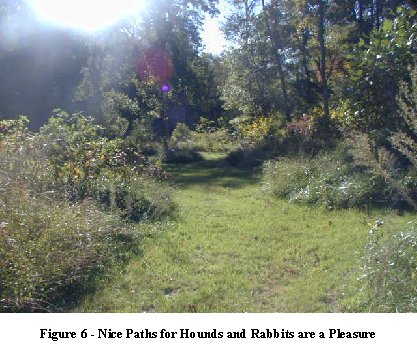 The final minor negative relates to watching the hounds work through the piles. I canít watch them when they get well into the piles, plus Iím constantly walking around a pile depending on which way the rabbit decides to move. This was easier when the piles were small and low, but itís a negative I can live with.
The final minor negative relates to watching the hounds work through the piles. I canít watch them when they get well into the piles, plus Iím constantly walking around a pile depending on which way the rabbit decides to move. This was easier when the piles were small and low, but itís a negative I can live with.
Conclusion
If you find yourself in a situation like I did when the pen you have finally starts to fail, bite the bullet and have it bulldozed. I actually came out ahead cost wise in that I had a logger in to clear the larger timber first. You canít stop with just the logging though as they leave ruts and branch piles that still need grooming. I figured that grooming would add a significant quality to my pen, particularly over the long run, so I had it bulldozed. Also, fortunately, only a small section of my fence had to come down, and this was only for two days.